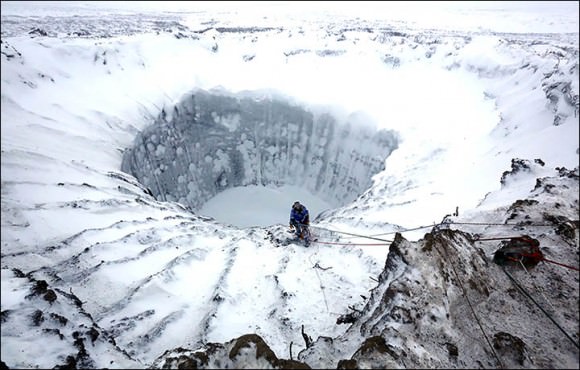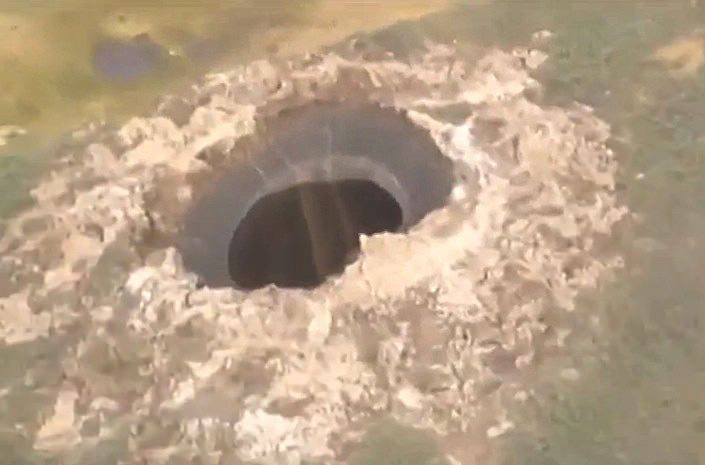What is it with Russia and explosive events of cosmic origins? The 1908 Tunguska Explosion, the Chelyabinsk bolide of February 2013, and now this: an enormous 80-meter 60-meter wide crater discovered in the Yamal peninsula in northern Siberia!
To be fair, this crater is not currently thought to be from a meteorite impact but rather an eruption from below, possibly the result of a rapid release of gas trapped in what was once frozen permafrost. The Yamal region is rich in oil and natural gas, and the crater is located 30 km away from its largest gas field. Still, a team of researchers are en route to investigate the mysterious hole further.
Watch a video captured by engineer Konstantin Nikolaev during a helicopter flyover below:
In the video the Yamal crater/hole has what appear to be streams of dry material falling into it. Its depth has not yet been determined. (Update: latest measurements estimate the depth of the hole to be 50-70 meters. Source.)
Bill Chappell writes on NPR’s “The Two-Way”:
“The list of possible natural explanations for the giant hole includes a meteorite strike and a gas explosion, or possibly an eruption of underground ice.”
Dark material around the inner edge of the hole seems to suggest high temperatures during its formation. But rather than the remains of a violent impact by a space rock — or the crash-landing of a UFO, as some have already speculated — this crater may be a particularly explosive result of global warming.
According to The Siberian Times:
“Anna Kurchatova from Sub-Arctic Scientific Research Centre thinks the crater was formed by a water, salt and gas mixture igniting an underground explosion, the result of global warming. She postulates that gas accumulated in ice mixed with sand beneath the surface, and that this was mixed with salt – some 10,000 years ago this area was a sea.”
The crater is thought to have formed sometime in 2012.
Read more at The Siberian Times and NPR.
UPDATE July 17: A new video (in Russian) of the hole from the research team has come out, and apparently it’s been made clear that it’s not the result of a meteorite. Exactly what process did produce it is still unknown, but rising temperatures are still thought to be a factor. Watch below (via Sploid).
(If any Russian-speaking UT readers would like to translate what’s being said, feel free to share in the comments below.)
Also check out the latest photos from the research expedition at The Siberian Times here.
UPDATE Nov. 13: Once the water in these holes froze solid scientists were able to enter and explore the bottoms. According to an article published on The Guardian, “eighty percent of the crater appears to be made up of ice and there are no traces of a meteorite strike.”

“As of now we don’t see anything dangerous in the sudden appearance of such holes, but we’ve got to study them properly to make absolutely sure we understand the nature of their appearance and don’t need to be afraid about them.”
– Vladimir Pushkarev, Director, Russian Center of Arctic Exploration
See more photos from inside the crater from the Russian Center of Arctic Exploration on The Siberian Times here.


It’s doubtful this is a meteorite crater. The Yamal Peninsula is covered with dozens of small circular lakes caused by similar subsurface gas explosions. Many of them have the appearance of water-filled impact craters.
First, if this is 80 meters in diameter, or 40 meters in radius, and say at a minimum 40 meters deep, that’ s not quite 10^9 kg of soil moved up order 40 meters, requiring (very roughly) the equivalent of 60 tons of TNT, at a minimum, and thus an equivalent magnitude of ~ 3.2 (again, roughly). Such an explosion should be detectable on seismological networks, such as the ones looking for nuclear testing.
Second, there is another mystery crater in Siberia – the Patomskiy crater – see http://siberiantimes.com/science/casestudy/features/a-volcano-or-a-ufo-what-created-this-mysterious-siberian-crater/
This one is in rock, not sediment, is about 160 meters in diameter, and is maybe 300 years old, but I have to wonder if they have a similar cause.
Well worth exploring further.. excuse the pun? Useful for practicing or training for a visit to a similarly shaped sky light crater on the Moon or Mars?
How about? Use mortars to shoot suspension cables across the crater. Carefully anchor the cables to support a cable crawling mobile camera/instrument package. The instrument could be lowered for close up inspections.
Looks like an iris and pupil to me.
To me it looks like an ordinary sinkhole, but the “lid” blown out instead of caving in. Maybe an explosive mixture of air and methane formed in the cavity, then a rock fell from the ceiling, hit another rock, and a spark flew..
“possibly the result of a rapid release of gas trapped in what was once frozen permafrost.”
is that’s true then “look out nelly!”, climate change has a lot more where that came from.
Hi, I’m from Russia. They are talking about this hole as about something occured because of material release from within the ground, no explosion, no heat. Just a big soil buble if there could be things like that :). Experts do understand what exactly happened but they are not sure why – the depth of melted ice level is just 70cm which is too low I suppose to create such a release of underground material
Thanks for clearing that up!
I’ll suggest a lightning strike onto methane-saturated tundra… Perhaps that dark layer underneath, deeper down, is somewhat like soggy peat, again, saturated with methane, which would, decomposing over the last few thousand years be the source of the explosive gas… An explosion occurred; I see the earth being lifted up and out, more than far away from the crater. Interesting, in any case.
Cant anyone try and be a bit realistic? With technology as it is today a small drone with a high def camera would be the least dangerous and lowest cost solution for exploring the depth and substance of this crater. It appears from this distance to be a gigantic sink hole common in Florida on a small scale. But why the risk to life by these nut cases getting far too close for safety?